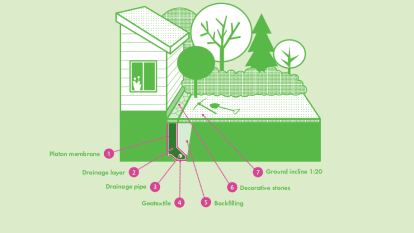House ground drainage
It is important to drain properly around a house so that you do not get problems with damp.
Surface water must be led off away from the house before it permeates down into the ground. This is done by inclining the ground away from the house. You should also keep in mind not to let plants and vegetation go straight up to house wall, but instead place a layer of single or decorative stones closest to the wall.
Well-functioning drainage consists of drainage and capillary-breaking materials, such as macadam, insulation boards and drainage pipes. Today's drainage pipes are made of plastic, which makes them easier to lay out compared to brick or concrete pipes. However, there is a risk of them becoming obstructed if you are not careful when backfilling.
You will need:
- Water level
- Wheelbarrow
- Pickax
- Folding rule
- Crowbar
- Spade
We recommend these materials:
- Macadam e.g. 11/16
- Macadam e.g. 16/32
- Draining mat or the like
- Geotextile fabric
Do this:
- Check whether there are any pipes in the ground before starting to excavate.
- Clear any vegetation from the soil.
- Dig out and save the top soil for later use.
- It is important to ensure that the foundation itself has a good protection against moisture. The foundation must be tarred and filleted at the connection between the foundation and wall. If the damp course needs to be reinforced, a drainage mat or a moisture resistant boards can be used. This is set against the part that is below the ground.
- Place geotextile fabric of class 2 where the macadam and drainage hose will be installed. This is to prevent the surrounding soil from penetrating the drainage layer. Geotextile fabric is folded around the drainage course and drawn up along the wall between the drainage layer and backfilling.
- The drainage pipe must be laid with a minimum incline of 1:200. Fill with a layer, about 8 cm, of macadam 11/16 around the hose and connect the line to the municipal storm water system or a culvert. Remember that the highest point of the line must lie far enough below the house structure, at least 20 cm.
- Backfill with coarse macadam (for example 16/32). The drainage layer should be at least 20 cm wide along the walls and other vertical structures.
- As a final surface, next to the house wall, you can perhaps complete the backfill with the existing macadam or decorative stones to keep the vegetation away from the house.
